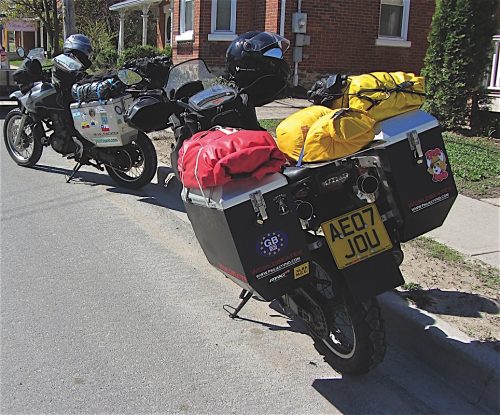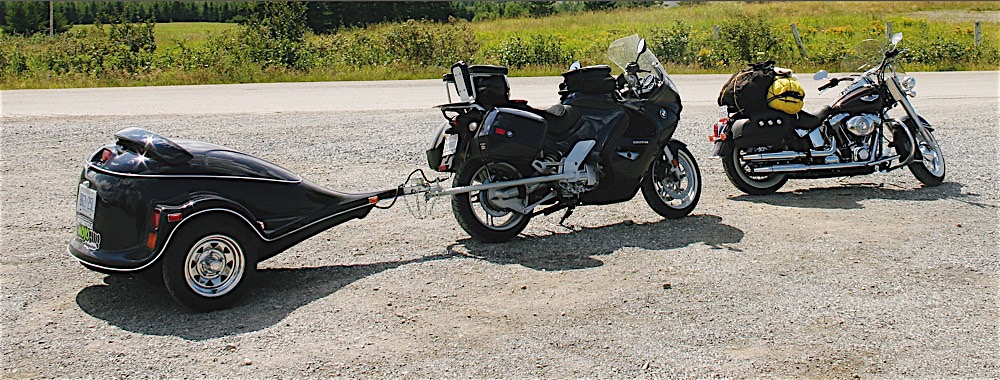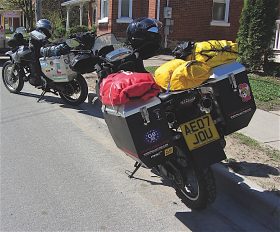A long-awaited bike trip can become an exercise in frustration without proper preparation.
One thing I hate when taking a long motorcycle tour is having to work on my bike while on the road. Sure, there are a few unavoidable things that must be done, some of them daily, but I don’t want to worry about having to change a tire or oil, or discover one morning that the bike won’t start because my four-year-old battery finally gave out.
When planning an extended trip, say a week to several weeks long, you should do a few things to ensure you have a trouble-free ride. Start by taking a close look at your bike. It’s not only your transportation while on the road; it basically replaces your home, taking you to your meals and to your overnight accommodations, and it provides you with countless hours of entertainment if the trip is trouble free.
SHOW YOUR BIKE SOME LOVE
 A thorough tune-up should be performed before leaving, so change the oil and filter, check the air filter and the spark plugs, and give the bike a good overall inspection and wash. Check the battery, its fluid level and the charging system, and make sure your brake pads are good enough to last the trip. Check all fluid levels, and if your bike’s driveline is a chain and sprockets, inspect them for wear. If they’re worn out, now’s the time to replace them. Don’t forget to adjust the chain. Carry a small can of chain lube; unless the chain is new, it probably won’t need another adjustment during your trip, if you lube it regularly.
A thorough tune-up should be performed before leaving, so change the oil and filter, check the air filter and the spark plugs, and give the bike a good overall inspection and wash. Check the battery, its fluid level and the charging system, and make sure your brake pads are good enough to last the trip. Check all fluid levels, and if your bike’s driveline is a chain and sprockets, inspect them for wear. If they’re worn out, now’s the time to replace them. Don’t forget to adjust the chain. Carry a small can of chain lube; unless the chain is new, it probably won’t need another adjustment during your trip, if you lube it regularly.
Adjust the tire pressures for the load you’ll be carrying, and make sure there’s enough tread left on the tires to last the duration of the trip; finding a shop that has the time to replace them while you wait is not always convenient. And what if the shop that you find doesn’t stock your size of tires? If your bike has tube-type tires, make sure your tubes are in good condition; if they are more than two years old, you might want to consider new ones. You should perform your part of the pre-trip tune-up with your bike’s toolkit. This way, you’ll see if it’s missing any important tools you might need on the road (toolkit items are explained in detail in the November 2014’s “Mojo Garage”). Another item to bring along in addition to a toolkit is a well-stocked first-aid kit.
ELECTRONICS
If you plan on bringing a laptop or other electronic devices, keep them in a vibration-free environment by storing them within your clothing, and keep your clothing in waterproof bags. If you are camping and not near electrical outlets, you may want to install a cigarette-lighter accessory outlet on your bike, and bring a compact power inverter to allow you to charge up your electronic devices.
A side-stand pad takes up very little space but can prove invaluable. You don’t want to zip open your tent in the morning to discover that your bike has placed itself gently on its side while you were asleep. A flat rock or crushed pop or beer can work in a pinch. Worse than discovering your bike on its side is discovering it’s missing. Carry a disc lock; it’s easy to stow and will deter an opportunistic thief.
Of course, in this modern age, many of the troubles described above can be alleviated by having a cell phone. One quick call to your roadside assistance club, and they’ll take your bike to a local dealer if you have a problem. I never resort to this, but I do carry my cell phone in case of a real emergency, which a punctured tire or burnt taillight is not.
One item that has recently become indispensible for me is a Bluetooth helmet communication system. I have a Schuberth C3 helmet with SRC-System communications, and by pairing it with my phone, I was able to communicate with home during a recent emergency while I was a thousand kilometres away.
Another way you can keep in touch with loved ones, or at least a way you can give them some peace of mind if you’re travelling alone, is to carry a Spot locator (findmespot.ca). It’s a small device that uses satellite technology to keep track of your progress, and for a small monthly fee, it transmits that information to whomever you choose via the Internet or a cellular network. It can also send out a distress signal pinpointing your location if you have a mishap on the road.
Some folks won’t leave home without a GPS; some won’t leave home with one. I can go either way, but aside from helping you navigate, a GPS can also track your ride, so if you discover a new, spectacular road along the way, you’ll have a record of it. Always take a paper map as a backup. Paper maps are free at the CAA if you are a member.
PACK PROPERLY
When packing, do it wisely. Pack light (no need to bring a microwave), distribute weight evenly, and place heavier items in the saddlebags, not in the top case or tank bag. This keeps the centre of gravity low, minimizing the impact to your bike’s handling. Also, if the suspension is adjustable on your bike, fine-tune it accordingly, especially the spring preload, but do this before it’s loaded so as not to force the preload adjusters.
And don’t forget to bring a spare key! It can easily be hidden on a bike, and can completely eliminate the headache and inconvenience of losing your original. I’ve seen it happen, so take heed.
Oh, and finally, don’t forget your camera, its charger and an extra memory card; your next tour might turn out to be the trip of a lifetime.
Technical articles are written purely as reference only and your motorcycle may require different procedures. You should be mechanically inclined to carry out your own maintenance and we recommend you contact your mechanic prior to performing any type of work on your bike.











